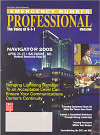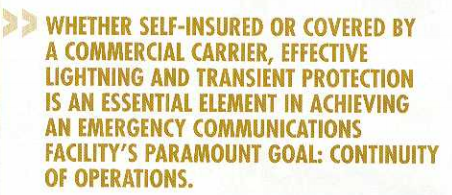Lightning Protection’s Potential Pitfalls and Best Practices
By Bruce Kaiser, Lightning Master Corp.
With a few basic and cost-effective measures, communications centers can bring lightning damage to an acceptable level, assuring full-time availability of critical services.
It was a dark and stormy night. The wind was blowing; the rain was horizontal. It was a fill-fledged hurricane. Calls were coming in left and right-downed power line reports, automobile accidents, water over a road and one ill-timed baby delivery. First the lights flickered; then they went out. A few seconds later, they came back on when the emergency generator fired up. What else could go wrong? Flash…bang! Communications were lost. What was the cause? Lightning.
Been there? Emergency services are critical at all times, but they are often most in-demand during adverse weather. Unfortunately, bad weather often features lightning. Besides being available at all times during all conditions is intrinsic to emergency response, any critical facility must be hardened against lightning damage.
What causes lightning to strike a particular structure? One theory is that lightning is not attracted by the best ground; it is attracted by the most critical facility. If an emergency communications facility is located next to a wastewater treatment plant, guess which one will be struck by lightning.
By taking a few basic and cost-effective measures, a communications facility can mitigate its risk of lightning damage to an acceptable level, assuring full-time availability of critical services.
Grounding
A typical facility’s most common problem is services grounding. Services include AC power, telephone, data, and radio communications. Any equipment served by more than one service is susceptible to damage from current flow caused by a difference in ground potential (voltage) between those services. In the case of a computer with a modem, the computer motherboard is at same potential of the telephone service ground. The service ground potential is the voltage of the ground rod or other electrode to which that service is attached. Each geographical location is at some potential. If the services enter the building at different locations, there may be difference in potential between service grounds. That difference in voltage causes current to flow from one ground to the other over the AC power and telephone conductors between them. With the computer in the middle, the current flow through it may damage the power supply, modem, or other components. There are fewer problems when they are at the same potential.
Solution

The easiest time to provide single- point grounding is during construction. Specify that all services enter the building at the same location, and that they be bonded together above grade. In an existing building, the services are sometimes located adjacent to one another, either by planning or by luck, in which case they need only be properly tied together electrically before being attached to ground. In most emergency communications facilities, however, the radio coaxial cables are grounded at a location remote from the AC power service ground. The communications tower is usually constructed wherever it will fit on the site, and the coaxial cables are run directly into the building through windows or other convenient openings. As a result, the coaxial cables have a different ground potential than the AC power.
The best solution in that situation is to reroute the coaxial cables so they enter the building with the AC power, telephone, and data services. Other possible solutions include installing surge suppressors grounded to the AC power ground upstream of the radios, or using isolation transformers to float the AC power ground potential.
Transient Voltage Surge Suppression
The second biggest problem at emergency communications Facilities is lack of transient voltage surge suppression (TVSS) on the services where they enter the building. A surge suppressor is a device designed to limit the voltage on a conductor. As the voltage rises beyond the designed operating voltage of the system, the device becomes conductive, and shunts the excess to ground. This voltage is referred to as the clamping voltage. If the operating voltage of the AC power system is 110 volts, the clamping voltage of the surge suppressor should be some voltage above the operating voltage, yet low enough to protect equipment – about 190 volts.
Solution
All services need surge protection: AC power, telephone, data from outside and between buildings in a campus environment, and radio frequency. Any wire is capable of conducting equipment –damaging transient (spike) into the facility; therefore, all need to be protected. Install appropriately rated and designed surge suppressors on all services entering the building. Surge suppressors should be located as close as possible to the point at which a service wire enters the building. If two wires are run through a building side-by-side, and one is protected by a surge suppressor and one is not, a transient on the unprotected wire may be inductively couple onto the protected wire. Reduce the possibility of equipment-damaging gremlins jumping from unprotected to protected wires by making certain that every service is grounded and surge suppressed at its service entrance.
Because of the manner in which surge suppressors operate, a primary, high capacity surge suppressor should be installed on the primary disconnect of the AC power system. Additional, supplementary surge suppressors should be installed on each AC power system Additional, supplementary surge suppressors should be installed on each AC power sub-distribution panel. This will protect equipment from both outside transients and transients generated inside the building by other loads, such as motors.
Structural Lightning Protection

Examples of both extremes can be found in the field. On one end is a medium size building at the base of a large communications lower, where the tower will tend to protect the building from direct strikes. At the other extreme is the 100-year-old courthouse- a masonry building with a metal cupola and dome on such a structure is not grounded or protected. A direct lightning strike to an ungrounded dome can cause all types of damage to equipment in the building, as well pose a hazard to personnel.
Solution
The solution involves using one of two sophisticated, active lightning protection technologies that expands the spectrum of lightning rod performance. These technologies are based upon influencing streamer formation. A streamer is the lightning-completing mechanism of the strike that originates on the earth’s surface. One technology, using early streamer emitting (ESE) air terminals, acts to attract lightning.

A lightning protection site survey should look at particular facility factors that could influence the site’s susceptibility to damage from lightning and other transients.
Factors Include:
- Location and grounding of each service entering the facility, such as AC power, telephone, data, and radio
- Design and integrity of the grounding system
- Type, location, and condition of transient voltage surge suppression on each service
- Design and condition of structural lighting protection on the facility and associated structures, such as communications towers
- AC power system design and integrity, including neutral/ground separation integrity
Facilities with multiple structures in a campus environment may present special challenges.
Once this information is obtained by a site visit, it is analyzed and a report is issued to the owner of the facility listing findings and recommendations for correcting deficiencies. The report should be detailed enough that the owner can conduct upgrades using either in-house personnel or contract labor. Much of this work may be integrated into a programmed or preventive maintenance schedule. The recommendations should detail specific equipment models and include installation estimates.
Installing grounding kits on radio frequency coaxial cables at building entrance.
Whether self-insured or covered by a commercial carrier, effective lightning and transient protection is an essential element in achieving an emergency communications facility’s paramount goal: Continuity of operations.
When stepped-leaders begin their journey downward form the storm cloud, the ESE terminal emits a streamer, the ground-based mechanism that completes the strike when it reaches a stepped-leader. Since the streamer is initiated early, it reaches the stepped-leaders first, and wins the competition. When they perform as designed, they attract lightning away from other areas to the ESE air terminal itself. It is vital to carefully locate the ESE air terminal to avoid attracting lightning to sensitive equipment, and an effective grounding system must be provided for the ESE terminal.
The second proven effective technology, using streamer –delaying air terminals, is designed to reduce the likelihood of a direct lightning strike. Streamer-delaying air terminals delay the formation of streamers form the protected structure. Therefore, a streamer form another object is more likely to win the competition, and the protected structure is struck less often.
Install an effective structural lightning protection system employing the technology most suited to the application. Consider all options and information carefully, and make decisions accordingly.
Personnel Safety and Routine Inspection
All three problems discussed above must be handled if an emergency communications center is to have full protection. The best founding and lightning rod system will not prevent damage caused by a transient on the power or telephone lines. The best surge suppression will not prevent damage caused by differences in service grounding potential. If the building is directly struck by lightning, all bets are off; it will probably suffer some kind of physical damage.
Ensuring the safety of personnel is the best reason to provide complete lightning protection. Several years ago, in Florida, there were several incidences where console operators suffered hearing damage from lightning strikes to the facility. After investigating the possible causes, it was decided to design surge suppressors for each of the services to the console, installing them in each console. This provided protection for the operators, regardless of any (or the lack of any) other protection. Special problems and situations such as this should be addressed individually.
Another factor to consider is the routine inspection and maintenance of the lightning protection system. All components should be inspected at least annually, and after any expansion or other work that could affect the system. One Tampa area facility began to experience lightning problems after a new lawn sprinkler system was installed. It was determined that the sprinkler installer’s inadvertently cut the grounding system conductors, probably not realizing what they were.
If your facility is self-insured, loss control becomes imperative. A lightning protection site survey provides an important starting point and budgeting tool (see Site Survey Example sidebar).However, whether self-insured or covered by a commercial carrier, effective lightning and transient protection is an essential element in achieving an emergency communications facility’s paramount goal: continuity of operations.





